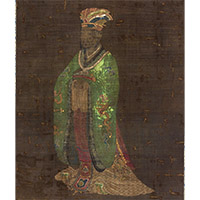仏教の美術―平安~室町
-

孔子像(部分) 伝粟田口隆光筆 室町時代・15世紀
本館 3室
2017年11月14日(火) ~ 2017年12月25日(月)仏教美術は日本美術を代表するジャンルの一つです。とくに平安後期の仏教美術の遺品には、日本的な仏教美術の美しさを極めた名品が数多く含まれます。絵画は鎌倉時代に入ると、仏教美術は鎌倉新仏教の興隆や禅宗の導入、あるいは新たな中国美術の影響などにともない題材、技法、様式の面で変化しますが、前代同様に優れた作品が盛んに制作されました。
絵画は、特集「室町時代のやまと絵―絵師と作品―」(10月24日(火)~12月3日(日)) に関連して、「弁才天十五童子像」など室町時代の作例を中心に、書跡は宝塔に関連した「一字宝塔経」や「泥塔経」などを展示します。
| 指定 | 名称 | 員数 | 作者・出土・伝来 | 時代・年代世紀 | 所蔵者・寄贈者・列品番号 | 備考 | |
| おすすめ | 重文 | 文殊菩薩立像 | 1躯 | 鎌倉時代・文永6年(1269) | 奈良・中宮寺蔵 | ||
| 仏涅槃図 | 1幅 | 室町時代・15世紀 | A-748 | ||||
| 十一面観音像 | 1幅 | 室町時代・15世紀 | A-114 | ||||
| 文殊菩薩像 | 1幅 | 鎌倉時代・14世紀 | A-869 | ||||
| 不動三尊像 | 1幅 | 室町時代・16世紀 | A-121 | ||||
| 愛染明王像 | 1幅 | 鎌倉時代・14世紀 | A-10411 | ||||
| 十二天像(火天) | 1幅 | 室町時代・15世紀 | 神谷傳兵衛氏寄贈 A-1051-2 | ||||
| 十二天像(伊舎那天) | 1幅 | 室町時代・15世紀 | 神谷傳兵衛氏寄贈 A-1051-4 | ||||
| 十二天像(月天) | 1幅 | 室町時代・15世紀 | 神谷傳兵衛氏寄贈 A-1051-7 | ||||
| 十二天像(羅刹天) | 1幅 | 室町時代・15世紀 | 神谷傳兵衛氏寄贈 A-1051-12 | ||||
| 十二天像(水天) | 1幅 | 室町時代・15世紀 | 神谷傳兵衛氏寄贈 A-1051-11 | ||||
| 十二天像(風天) | 1幅 | 室町時代・15世紀 | 神谷傳兵衛氏寄贈 A-1051-10 | ||||
| 羅漢像 | 1幅 | 室町時代・15世紀 | A-1229 | ||||
| おすすめ | 弁才天十五童子像 | 1幅 | 室町時代・15世紀 | A-1228 | |||
| 子島荒神像 | 1幅 | 室町時代・16世紀 | A-32 | ||||
| おすすめ | 孔子像 | 1幅 | 伝粟田口隆光筆 | 室町時代・15世紀 | A-7095 | ||
| 国宝 | 線刻蔵王権現像 | 1面 | 奈良県吉野郡天川村金峯山出土 | 平安時代・長保3年(1001) | 東京・西新井大師総持寺蔵 | ||
| おすすめ | 重文 | 文殊菩薩立像納入品 | 1巻 | 鎌倉時代・文永6年(1269) | 奈良・中宮寺蔵 | ||
| おすすめ | 重文 | 文殊菩薩立像納入品断片 | 1巻 | 鎌倉時代・文永6年(1269) | 奈良・中宮寺蔵 | ||
| おすすめ | 重文 | 法然上人伝絵巻 巻第十九 | 1巻 | 室町時代・15世紀 | 奈良・當麻寺奥院蔵 | ||
| 造塔功徳経仏説不増減経仏説堅固女経 | 1帖 | 鎌倉時代・13世紀 | B-2014 | ||||
| 柿経 | 15枚 | 山形市山寺 立石寺 | 鎌倉時代・13世紀 | 清原英白氏寄贈 B-2460 | |||
| 経石 | 47個 | 兵庫県宍粟市山崎町 上ノ上経塚出土 | 室町時代・16世紀 | 保井安治郎氏寄贈 B-2147 | |||
| おすすめ | 泥塔経 | 17個 | 出土地不詳 | 平安時代・12世紀 | 村岡爲三郎氏寄贈 B-2183 | ||
| おすすめ | 一字宝塔法華経巻第一(心西願経) | 1巻 | 京都・安楽寿院伝来 | 平安時代・12世紀 | 田中親美氏寄贈 B-3326 | ||
| 重美 | 舎利勘計記 | 1幅 | 藤原為兼筆 | 鎌倉時代・永仁元年(1293) | B-3043 | ||
| 書状案断簡 | 1幅 | 文覚筆 | 鎌倉時代・12~13世紀 | B-3198 | |||
| 重文 | 金銅五種鈴(のうち四種) | 1具 | 鎌倉時代・13世紀 | 静岡・尊永寺蔵 | |||
| 迦陵頻伽文華鬘(模造) | 1面 | 山脇洋二作 | 昭和時代・20世紀 原品=平安時代・12世紀 | E-13823 | |||
| 金銅迦陵頻伽文華鬘(模造) | 1面 | 山脇洋二作 | 昭和時代・20世紀 原品=平安時代・12世紀 | E-13831 | |||
| 蓮花花瓶文華鬘 | 1面 | 原品=室町時代・15世紀 | E-13815 | ||||
| 金銅宝相華文華鬘 | 1面 | 鎌倉時代・13世紀 | E-19966 |
